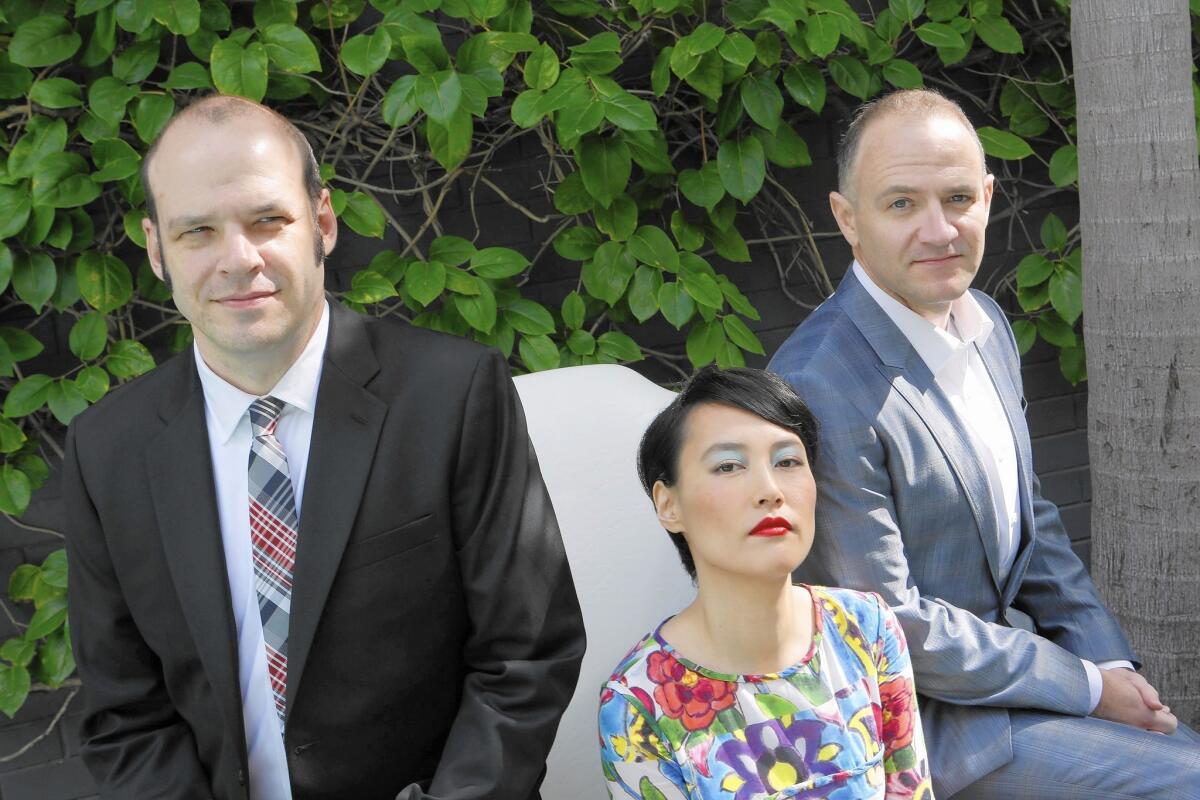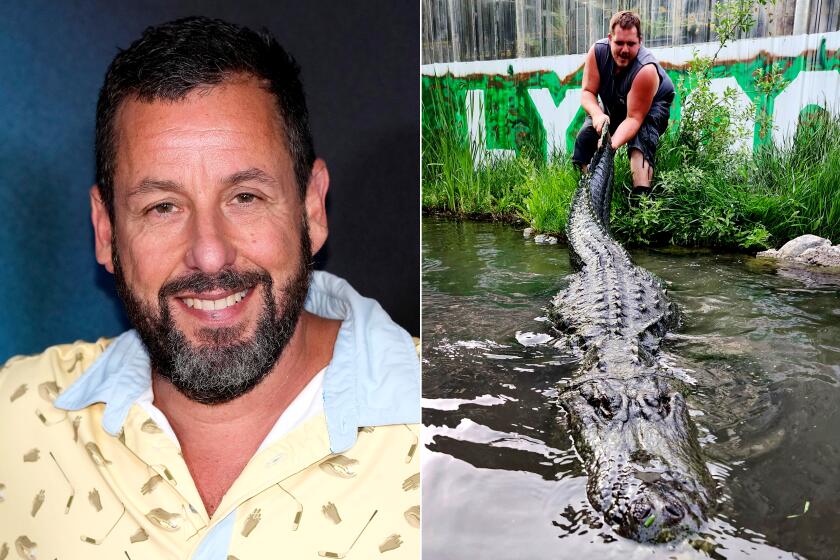‘Kumiko, the Treasure Hunter’s’ path winds through fact, legend, truth

- Share via
Truth, supposedly, is stranger than fiction — except when truth and fiction intertwine to create some wondrous, unpredictable hybrid.
The film “Kumiko, the Treasure Hunter” is a fictional take on a true story that was initially distorted and misunderstood and transformed into some sort of tech-age urban legend. The filmmaking team of brothers David Zellner and Nathan Zellner have followed the fiction to create something emotionally true, veering toward the magical unpredictability of a dream.
The film has its grounding in the story of Takako Konishi, a 28-year-old Tokyo office worker mysteriously found dead outdoors in Minnesota in 2001. As news of her story began to filter out, mostly online, it seemed she had mistakenly believed the money left hidden in the snow at the end of the 1996 Coen brothers movie “Fargo” was real and she had gone off in search of it. Except that wasn’t the real story at all.
Now “Kumiko, the Treasure Hunter” takes the story in a whole other direction, treating the “Fargo” aspect of the story as if it were true to create something unexpectedly haunting. In the film, now playing in Los Angeles and expanding around the country, Kumiko (Rinko Kikuchi) leaves behind her lonely life in Tokyo for a solo adventure abroad. As she becomes increasingly adrift in a strange land, she becomes more and more determined to see her quest through to the end. Somehow, as the Zellners’ tell it, a sad story of loneliness and failure becomes emotionally resonant, and one of grace.
The Zellners, originally from Colorado but longtime Texas residents and now fixtures of the Austin film community, first heard the story when its buried-treasure twist was still believed to be true. They had already been working on a screenplay based on the story when they learned that Konishi was actually in search of an American man who had broken her heart, with the inaccurate “Fargo” connection rising from miscommunication with police in North Dakota.
“At first we were caught off-guard,” said David Zellner, during a recent interview in Los Angeles alongside his brother and Kikuchi. “But then we loved it all the more that it was a legend. It was the antiquated notion of someone going on a treasure hunt across the globe, from the age of exploration like the conquistadors or such. So we stayed true to that and then filled in the gaps with what felt right.”
“After a while we stopped looking,” added Nathan Zellner of their research. “We had already done all this creative investigation, we came up with our own reasons why this woman would have gone on this journey, her motivations and the kind of person it would take to make this leap of faith.”
The Zellners’ creative leap has turned out well. After premiering as part of the prestigious U.S. dramatic competition at the 2014 Sundance Film Festival and also playing the Berlinale, “Kumiko” was nominated for two Spirit Awards, for lead actress and director.
The film’s L.A. premiere was part of the Next Fest, a summertime festival put on by Sundance. After the screening the Zellners were talking with Werner Herzog, who has himself walked the line between fact and fiction in his movies and called their work “a very beautiful, very deeply touching film.”
The Zellners cast the Japanese actress Kikuchi — an Oscar nominee for Alejandro G. Inarritu’s “Babel” — in part because of the physicality of her performances. (Her haircut in the film was based in part on the lead from Herzog’s 1977 film “Stroszek.”) They became particularly taken with the way she would walk in character, which they came to refer to as “the Kumiko shuffle.”
For Kikuchi, who in the film is often seen simply walking alone, with little dialogue even before her Japanese-speaking character becomes lost in America, the challenges of the role were what excited her. “I prefer when there is not much dialogue in a movie, so that was not a problem,” she said through a translator. She likewise was intrigued by the character’s enigmatic qualities, and in fact looked to amplify some of those.
“To play this character who is very difficult to understand,” Kikuchi added, “for me what was important was to bring the reality of this woman to life. I think it was very important to make her unique.”
Kumiko’s only real friend in the movie is her pet rabbit, named Bunzo. Bringing an additional Internet-age twist to the story, fans of the movie began using the phrase #TeamBunzo online, which has since been integrated into the film’s marketing.
“You never know how anyone is going to react to anything,” said David Zellner of the popularity of Bunzo. “You make films to have a dialogue with people and to hope people connect and that’s the most we could ask for.”
For the Zellners, the ambiguity of Kumiko was something they were always leaving room for, while also being careful not to make her just some kind of weirdo.
“We wanted to give it room to breathe and just kind of embrace the quiet moments,” said David Zellner. “But we always wanted to have a sense of empathy for Kumiko. We never wanted to make fun of her. Since the movie is from her point of view, that was the opposite of what we wanted to do.”
The film was shot pretty much in order, with the production first in Japan for six weeks and then in Minnesota for nine weeks. Save a few key members such as cinematographer Sean Porter, separate crews were used in the two countries.
Once in Minnesota, needing to have Kumiko walking along slushy streets, through snow-covered woods and across a frozen lake, the production was painfully dependent on the location providing a specific kind of weather.
“We were terrified, so much of it was weather-dependent,” said Nathan Zellner. “It was kind of the opposite of what you normally do, if the weather was too nice we’d shoot indoors and then as soon as it was nasty we could move things around and get out there.”
In the years since the Zellners began working on what would become “Kumiko,” they made assorted shorts and two features, the lost-cat story “Goliath” and the childhood fable “Kid-Thing.” Among the various reasons the film gestated for so long was that the production needed clearances to use footage and music from “Fargo.” (And as of now, the Zellners do not believe the Coens have seen “Kumiko.”)
“A lot of that was just making our intentions clear,” said David Zellner of the rights process. “The last thing we want was for this to come off as a wacky knockoff, a spoofy riff on ‘Fargo.’ We really wanted this to be its own piece and to be very respectful to that material. We were working off of the legend and it was part of the legend.”
More to Read
Only good movies
Get the Indie Focus newsletter, Mark Olsen's weekly guide to the world of cinema.
You may occasionally receive promotional content from the Los Angeles Times.









